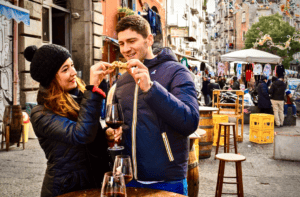The allure of exploring cities through food tours has captured the imagination of travelers and culinary enthusiasts worldwide. These tours, whether on foot or by bus, offer a unique lens to experience the vibrant heart of a city’s culture, one bite at a time. Food tours are not just about tasting local delicacies; they’re an expedition into the soul of a city, revealing details behind each dish and the people who create them.
This journey, be it through the streets of a historic downtown or the serene paths of a quaint neighborhood, allows participants to connect with a city’s culinary identity. Walking tours invite an intimate, sensory engagement with the surroundings, while bus tours provide a comprehensive overview, whisking food lovers from one culinary hotspot to another. Both forms of tours have grown in popularity, becoming a must-do for visitors seeking to combine their love of food with the thrill of travel.
In the following sections, we’ll explore the world of food tours, contrasting the immersive experience of walking tours with the convenience and breadth of bus tours. We’ll explore their unique advantages and consider the factors that might influence your choice.
Walking Food Tours: A Closer Look

Walking food tours offer a unique and immersive way to explore a city’s culinary. These tours are more than just about food; they encompass walking, storytelling, and a deep dive into local cultures.
Immersive Culinary Experience
Walking food tours allow participants to explore lesser-known spots and interact closely with local culinary scenes. Unlike bus tours, walking tours provide a more intimate experience. Participants have the opportunity to visit unique restaurants and eateries that might be off the beaten path, often getting the chance to meet executive chefs or owners personally. This hands-on approach provides a closer connection to the food and the stories behind it, making the experience memorable.
Pros of Walking Food Tours
– Personalized Experience: Each tour is guided by local food experts who share insider tips, stories, and history, offering a perspective beyond what’s found in guidebooks.
– Enhanced City Experience: Walking allows you to experience the city in greater detail. It affords the time to observe, interact with the environment, and appreciate the nuances of the city’s character and charm. This slower pace enables a more thorough and engaging exploration compared to viewing the city through a bus window.
– Health Benefits: The physical aspect of walking, often covering a distance of 1.5 miles or more, helps to offset the calories consumed during the tour.
– Social Interaction: Walking food tours are a great way to meet people from different parts of the world, enriching the experience through shared stories and discoveries.
– Cultural Insights: Guides weave historical tidbits and personal anecdotes into the tour, providing a deeper understanding of the local community and culture.
Cons of Walking Food Tours
– Physical Demand: Walking tours can be more physically demanding. It doesn’t mean you’re running a marathon, but it might not suit everyone, especially those with mobility issues.
– Weather Dependent: Unlike bus tours, walking tours are more susceptible to weather conditions, which can affect the comfort and feasibility of the tour.
Bus Food Tours: A Different Perspective

While bus food tours offer an alternative way to explore a city’s culinary scene, they present a different set of experiences compared to walking tours.
Experiencing the City from a Different Angle
Bus food tours provide a broader, less detailed overview of a city. They cover more ground, allowing participants to see various neighborhoods and eateries that might be far apart. This can be advantageous for those with limited time or mobility issues, offering a snapshot of the city’s culinary offerings without the need for extensive walking.
Pros of Bus Food Tours
Accessibility: Suitable for those who prefer less walking due to physical limitations or personal preference.
Convenience: With pre-planned itineraries, bus tours can be more straightforward, especially for those unfamiliar with the city.
Weather Resilience: Bus tours are less affected by weather, providing a comfortable experience regardless of the conditions.
Cons of Bus Food Tours
Limited Interaction: The nature of traveling by bus means there’s less opportunity to immerse oneself fully in the local culinary scene and interact closely with the community.
Less Personalization: Bus tours often follow a fixed route and schedule, offering less flexibility to explore spontaneously or linger at favorite spots.
Potential for Traffic Delays: Being on the road can mean delays due to traffic, which might limit the time spent at each food stop.

Comparative Analysis: Walking vs Bus Tours
Now, when comparing walking and bus tours, each offers a distinct way to experience a city, with different advantages and considerations.
Flexibility and Pace
– Walking Tours: These tours provide flexibility and a personal pace. Tourists can stop for photos, explore areas in detail, and immerse themselves in the local culture and atmosphere. However, they can be physically demanding and may not be suitable for everyone.
– Bus Tours: Bus tours offer a relaxed pace and cover a larger area in a shorter time. They are ideal for those with limited mobility or who prefer not to walk long distances. While comfortable, bus tours may lack the same level of interaction and depth as walking tours.
Areas Covered
– Walking Tours: Typically focus on specific neighborhoods or landmarks, offering in-depth exploration.
– Bus Tours: Cover more ground and can include multiple neighborhoods and landmarks.
Cost Considerations
– Walking Tours: Generally less expensive, though they may have additional costs such as entrance fees to attractions.
– Bus Tours: Tend to be more expensive, but often include amenities like air conditioning and bathrooms. Some offer hop-on, hop-off options for flexible exploration.
Experience and Interaction
– Walking Tours: Allow a closer look at the city’s details and hidden spots, offering a more intimate and engaging experience.
– Bus Tours: Provide a broader overview but may lack the intimacy of walking tours, offering more observational experiences.
Seasonal Considerations
– Walking Tours: Ideal in favorable weather conditions, like summer, but can be challenging in colder months.
– Bus Tours: A comfortable alternative in winter, offering a warm and sheltered way to explore the city.
Tour Guides and Storytelling
– Walking Tours: Benefit from more personalized storytelling and interaction with guides, enhancing the tour experience.
– Bus Tours: While informative, may have limitations in personal storytelling due to the nature of the tour and the size of the group.

Sustainability and Environmental Impact
Sustainability and environmental impact are crucial considerations in the realm of food tourism, particularly when comparing walking and bus tours. Food tourism significantly contributes to local economies and supports sustainable rural livelihoods by promoting local food systems and agricultural practices. Walking food tours align more closely with sustainable tourism principles, primarily because they do not involve the use of vehicles that emit gasses, thus having a lower environmental footprint. By exploring cities on foot, these tours minimize the carbon footprint, offering an eco-friendlier way to experience local culinary delights and culture.
Moreover, walking food tours support a deeper understanding of local food heritage, contributing to a stronger bond between travelers and the destinations they visit. In contrast, bus tours, while offering accessibility and convenience, rely on fuel-powered transportation, which has a higher environmental impact. While both types of tours have their unique merits, walking tours stand out for their environmentally friendly and immersive nature, making them an ideal choice for the eco-conscious traveler.
In conclusion, embracing walking tours offers a richer, more intimate experience of a city’s culinary culture compared to bus tours. Walking tours not only provide an up-close and personal view of a destination but also allow visitors to deeply engage with the local culture and atmosphere. Unlike bus tours, walking tours afford the opportunity to interact directly with local communities, feel immersed into the history and architecture of an area, and discover unique spots that might otherwise be missed.
Ultimately, while bus tours have their advantages, especially in terms of accessibility and convenience, walking tours stand out for their immersive nature and minimal environmental impact. They are a splendid way to experience the vibrancy and richness of a city’s culinary scene, offering a journey that is as much about the journey itself as the destination.
For those who appreciate the charm of a walking tour, we invite you to discover our carefully crafted tours in destinations around the globe, each guided by expert food locals.
